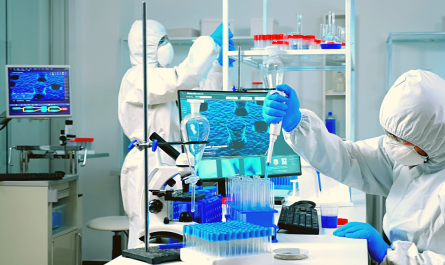
Photodynamic therapy (PDT) is an innovative technique that uses light to activate a photosensitizing drug, which then kills cancer cells. This therapy has shown promising results in treating various types of cancer and is expected to revolutionize cancer treatment in the near future.
What is Photodynamic Therapy?
Photodynamic therapy works by first administering a photosensitizing drug that is absorbed by cancer cells. These photosensitizing drugs are inactive until activated by light of a specific wavelength that is delivered by a laser. When exposed to light, the photosensitizing drug produces reactive oxygen species, such as singlet oxygen, that directly kill cancer cells or damage their DNA. Damaged cells undergo apoptosis (cell death) or necrosis. As the photosensitizing drug is preferentially absorbed by cancer cells, the resultant cell death is highly localized to the areas that were exposed to light. Nearby normal tissues are largely unaffected.
The Mechanism of Photodynamic Therapy
The exact mechanism behind how photodynamic therapy kills cancer cells is still being fully elucidated. However, research has shown that when the photosensitizing drug absorbs photons of light, it reaches an excited energy state. In this excited state, the drug can interact with oxygen molecules present in the tissue and produce reactive oxygen species. The most important reactive oxygen species produced is singlet oxygen, which causes localized oxidative damage to cellular components like membranes, mitochondria and DNA. This results in cancer cell death through apoptosis or necrosis. The action is highly localized to the regions exposed to light as light penetration is limited in tissues. Nearby normal cells that do not take up the photosensitizing drug remain unharmed.
Types of Photosensitizing Drugs
Currently, the most widely used photosensitizing drugs in PDT are porfimer sodium (Photofrin), aminolevulinic acid (ALA) and its methyl ester (MAL), verteporfin and lutetium texaphyrin. Each photosensitizer has its own characteristics in terms of wavelength absorbed, affinity for certain tissues, potency and toxicity. For example, Photofrin absorbs red light of 630 nm wavelength and has been approved to treat several cancer types. ALA induces the formation of the photosensitizer protoporphyrin IX inside cancer cells and absorbs blue light of 415 nm. It has shown effectiveness against certain types of cancer affecting skin, bladder, lung and Barrett’s esophagus. Ongoing research continues to develop new photosensitizing agents with improved properties.
Applications of Photodynamic Therapy in Cancer Treatment
Thanks to its localized action, high selectivity for cancer cells and minimal invasiveness, PDT has emerged as a promising treatment option for various types of cancers:
– Head and Neck Cancers: PDT using ALA has shown good response rates for treating premalignant conditions like leukoplakia as well as early stage cancers of the oral cavity, larynx and esophagus.
– Lung Cancer: Early results with Photofrin-PDT for treating non-small cell lung cancer show improved survival compared to other treatments. It is also being studied for mesothelioma.
– Gastrointestinal Cancers: PDT helps treat Barrett’s esophagus, a premalignant condition, very effectively using ALA. It is also studied for cancers of the esophagus, stomach and colon.
– Genitourinary Cancers: ALA-PDT produces excellent response in bladder cancer and helps avoid repeat TURBT surgeries. Researchers are also exploring its use in prostate cancer.
– Brain Tumors: PDT may help treat newly diagnosed as well as recurrent brain tumors by acting selectively on tumor tissue while sparing healthy brain cells.
– Skin Cancers: Photodynamic therapy has emerged as a well-established option for treating actinic keratosis, Bowen’s disease and basal cell carcinoma of the skin with good cure rates.
Advantages of Photodynamic Therapy
The key advantages of PDT over other cancer therapies include:
– Minimally invasive – It does not require surgery in most cases, just the insertion of a light applicator for treatment. This makes it well-tolerated by patients.
– Highly localized – Only the areas directly exposed to light receive treatment, sparing surrounding normal tissues from damage.
– Ability to retreat lesions – If a tumor returns, PDT can be safely repeated at the same site unlike surgery or radiation.
– Outpatient treatment – PDT is usually administered on an outpatient basis with quick recovery times compared to other therapies.
– Preservation of function – As only the tumor tissue is specifically targeted, PDT helps retain organ functionality unlike surgery which may lead to loss of function.
– Applicable to multiple tumor types – Depending on the photosensitizer used, PDT can treat a variety of cancers affecting different organs.
– Low adverse effects – While acute effects like skin photosensitivity may occur, long-term side effects are minimal. Damage to healthy tissues is low.
Future Prospects
With ongoing research to develop improved light delivery methods, new photosensitizing agents and combined treatment protocols, the horizon for PDT continues to expand. It shows excellent promise for precise, non-invasive management of cancer at an early stage, neoadjuvant downsizing of tumors before surgery, treatment of recurrent cancers as well as multi-drug resistant cases. As a targeted, low toxicity option, PDT has the potential to play a major role in individualized cancer management in the future.
In conclusion, photodynamic therapy leverages the unique properties of light and photosensitizers to precisely destroy cancer cells from within. With refinements, it could revolutionize the way many common tumor types are treated with minimal side effects. PDT continues to emerge as a powerful tool in the cancer treatment armamentarium.
*Note:
- Source: Coherent Market Insights, Public sources, Desk research
- We have leveraged AI tools to mine information and compile it

